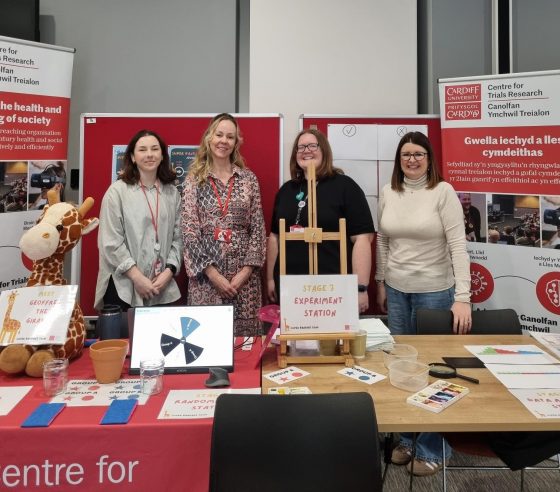Centre for Trials Research at the Cardiff Science Festival “Be a Scientist” Event
31 March 2025
Cardiff Science Festival
Be a Scientist
Tuesday, 25 February 2025
Linda Adara, Sarah Rawlinson, Kim Munnery, Kelly Lewis, Dolce Advani, Ceri Fayne, Nuria Marquez Almuina
In celebration of this year’s Cardiff Science Festival, events were held across Wales’ capital between 22nd February and 2nd March 2025 to inspire and educate. Cardiff University staff, students, and volunteers brought the festival to life with exciting events popping up across Cardiff, giving visitors the opportunity to uncover the science of everyday life.
We are a team of research support co-ordinators, data managers, and trial managers representing the Centre for Trials Research (CTR), Cardiff University at the ‘Be a Scientist!’ event.
We saw 506 people attend over the course of the day, with people arriving from all over South Wales to explore our research and the variety of ways the sciences support life, health, and wellbeing.
We set up an interactive stand with ‘have a go’ activities and experiments for young children aged six and upwards to experience what being a scientist is really like and talked to visitors about medical trials.
Through narrative storytelling and posters, children met Geoffrey Giraffe with a broken tail and learnt that he is taking part in a medical trial of a new super bandage to see if it works. 139 young children were interested in our work and participated in Geoffrey’s trial, learning the concepts of hypothesising, randomising, experimentation, data analysis, and results at each stage of the journey.
After hypothesising if the super bandage will fix Geoffrey’s tail, children moved to the randomisation station where they could choose a coloured token or spin an e-wheel to join the intervention or control group. We found that the e-wheel was the most popular randomisation activity with 95 participants and 44 for the coloured tokens. Next, they received treatment, painting an experimental bandage which was coated in wax or holding a prepared bandage under a UV light to reveal if it had worked. Both experiments were equally popular, and children were very excited to know if the tail was fixed or still broken. Children then moved to our data analysis station where they built graphs and 3-D datasets of Geoffrey’s healing with Lego blocks. Finally, children completed their learning journey by displaying their experiment results on our display board and the team revealed which group they had joined and how their results helped scientists know which treatments to recommend to doctors and nurses.



Children gave us positive feedback when engaging with each of the stations:
‘I hypothesise that there is a bone broken.’
‘I can say randomisation.’
‘The treatment worked!’
‘We did a building calculator.’
‘The fixed bone is winning!’
Adult visitors were impressed with our stand and ability to engage young children by turning complex ideas into fun and playful activities:
‘They are having a great time exploring.’
‘My little one really enjoyed taking part in this stall. It was well pitched and a fun way to explain randomisation, especially for little ones, it wasn’t made overly complicated to understand.’
‘The Lego really brings the data analysis to life.’
Every participant was given a CTR gift and handout with reminders of the activities, information about trials science, and examples of how data can be used in healthcare research.

The team agreed that the event gave us a unique opportunity to share our work at CTR with new audiences and that taking part helped us to see our research from a new perspective and think creatively, generating innovative ideas to engage younger participants. We are proud to inspire the next generation of scientific researchers!
- December 2025
- October 2025
- June 2025
- May 2025
- April 2025
- March 2025
- February 2025
- December 2024
- November 2024
- October 2024
- September 2024
- July 2024
- June 2024
- May 2024
- April 2024
- March 2024
- December 2023
- November 2023
- September 2023
- July 2023
- June 2023
- April 2023
- March 2023
- February 2023
- December 2022
- November 2022
- October 2022
- September 2022
- August 2022
- July 2022
- June 2022
- May 2022
- April 2022
- March 2022
- February 2022
- January 2022
- November 2021
- September 2021
- July 2021
- June 2021
- May 2021
- March 2021
- February 2021
- December 2020
- November 2020
- September 2020
- August 2020
- July 2020
- January 2020
- December 2019
- October 2019
- September 2019
- July 2019
- June 2019
- May 2019
- April 2019
- February 2019
- December 2018
- November 2018
- October 2018
- September 2018
- August 2018
- July 2018
- June 2018
- May 2018
- April 2018
- March 2018
- December 2017
- October 2017
- August 2017
- July 2017
- June 2017
- May 2017
- April 2017
- March 2017
- February 2017
- January 2017
- December 2016
- October 2016
- August 2016
- June 2016
- April 2016
- March 2016
- February 2016